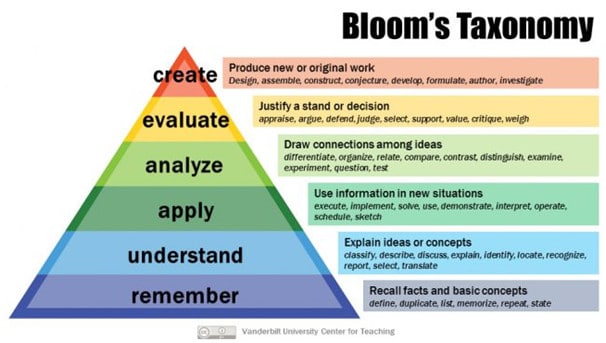 At the most basic level, an investor would need to be able to remember investment concepts. A value investor should be able to remember that the Price/Earnings ratio should be calculated diving the price of a stock by the 12-month trailing earnings per share. This can easily be captured in lecture slides.
The next level is understanding. The investor should have an underlying grasp of the mathematics behind a financial ratio. This same value investor has to be aware that as earnings drop in recession, without a corresponding drop in price, the P/E ratio will go up higher. Similarly, an increase in price will also increase the P/E ratio. It is harder to capture this on lecture slides as understanding hinges on a student’s mathematical background.
The next level is application. At this stage an investor should be able to dig into a website to extract the current price of a stock, dig out the earnings per share from a financial report and calculate the P/E ratio of a stock. This is even harder to capture in slides but this can be taught through practical exercise.
Beyond the first three levels, it becomes increasingly harder to advance through the levels of mastery in Bloom’s taxonomy via self-study and personal reflection. The next levels may require an actual investment practice or a training program because students will constantly challenge the lecturer with questions that cannot be anticipated during lesson planning.
At the fourth level, the investor should be able to analyse and draw connection among ideas. First, the value investor must convince himself that historically low P/E counters tend to do better historically. With this in mind, he should be able to make a value judgment that a stock with a lower P/E will have a higher probability of doing better than a similar counter with a higher P/E. A higher general intelligence is required for the learner to reach this level of mastery.
The penultimate level is reached when the investor is able to evaluate the low P/E strategy relative to all the other strategies available to investors. When evaluating a low P/E strategy relative to a high dividend yield strategy, it is not all that bad because both are value measures and may result in the same kind of portfolio behaviour. The challenge arises when the investor has to weigh the low PE strategy against a high growth strategy where the investor has to deal with contradictory facts that emerge during analysis. At this stage, the investor has to find some way to break the impasse and decide on which strategy to implement. This requires a different way of looking at investing such as quantitative back-testing.
The final level is reached when the investor can begin to innovate and create something new with the low P/E strategy. At lower levels of mastery, it can be about reinforcing a low P/E strategy with a high momentum strategy to increase returns and lower risks. At a more advanced level, the investor can create their own forward P/E ratio based on their projection of earnings by reading financial statements. The final level may not even be reached by an instructor. A multi-disciplinary approach is often required to attain this level.
Most investors will be able to attain the first three or four levels of mastery, but actually taking on the mantle of an investment trainer will force the trainer to constantly grapple with higher levels of mastery. This is because students will often throw curve balls during class and the trainer would have to react by not just coming up with the correct answer, but to explain it in a way that can be easily understood by the audience.
At the most basic level, an investor would need to be able to remember investment concepts. A value investor should be able to remember that the Price/Earnings ratio should be calculated diving the price of a stock by the 12-month trailing earnings per share. This can easily be captured in lecture slides.
The next level is understanding. The investor should have an underlying grasp of the mathematics behind a financial ratio. This same value investor has to be aware that as earnings drop in recession, without a corresponding drop in price, the P/E ratio will go up higher. Similarly, an increase in price will also increase the P/E ratio. It is harder to capture this on lecture slides as understanding hinges on a student’s mathematical background.
The next level is application. At this stage an investor should be able to dig into a website to extract the current price of a stock, dig out the earnings per share from a financial report and calculate the P/E ratio of a stock. This is even harder to capture in slides but this can be taught through practical exercise.
Beyond the first three levels, it becomes increasingly harder to advance through the levels of mastery in Bloom’s taxonomy via self-study and personal reflection. The next levels may require an actual investment practice or a training program because students will constantly challenge the lecturer with questions that cannot be anticipated during lesson planning.
At the fourth level, the investor should be able to analyse and draw connection among ideas. First, the value investor must convince himself that historically low P/E counters tend to do better historically. With this in mind, he should be able to make a value judgment that a stock with a lower P/E will have a higher probability of doing better than a similar counter with a higher P/E. A higher general intelligence is required for the learner to reach this level of mastery.
The penultimate level is reached when the investor is able to evaluate the low P/E strategy relative to all the other strategies available to investors. When evaluating a low P/E strategy relative to a high dividend yield strategy, it is not all that bad because both are value measures and may result in the same kind of portfolio behaviour. The challenge arises when the investor has to weigh the low PE strategy against a high growth strategy where the investor has to deal with contradictory facts that emerge during analysis. At this stage, the investor has to find some way to break the impasse and decide on which strategy to implement. This requires a different way of looking at investing such as quantitative back-testing.
The final level is reached when the investor can begin to innovate and create something new with the low P/E strategy. At lower levels of mastery, it can be about reinforcing a low P/E strategy with a high momentum strategy to increase returns and lower risks. At a more advanced level, the investor can create their own forward P/E ratio based on their projection of earnings by reading financial statements. The final level may not even be reached by an instructor. A multi-disciplinary approach is often required to attain this level.
Most investors will be able to attain the first three or four levels of mastery, but actually taking on the mantle of an investment trainer will force the trainer to constantly grapple with higher levels of mastery. This is because students will often throw curve balls during class and the trainer would have to react by not just coming up with the correct answer, but to explain it in a way that can be easily understood by the audience.
Christopher Ng Wai Chung teaches the Early Retirement Masterclass under Dr. Wealth. You can sign up for the next free preview on 19th December by following this link: https://www.eventbrite.sg/e/early-retirement-masterclass-workshop-19-dec-2019-thu-tickets-84567532767?aff=EDM1.






